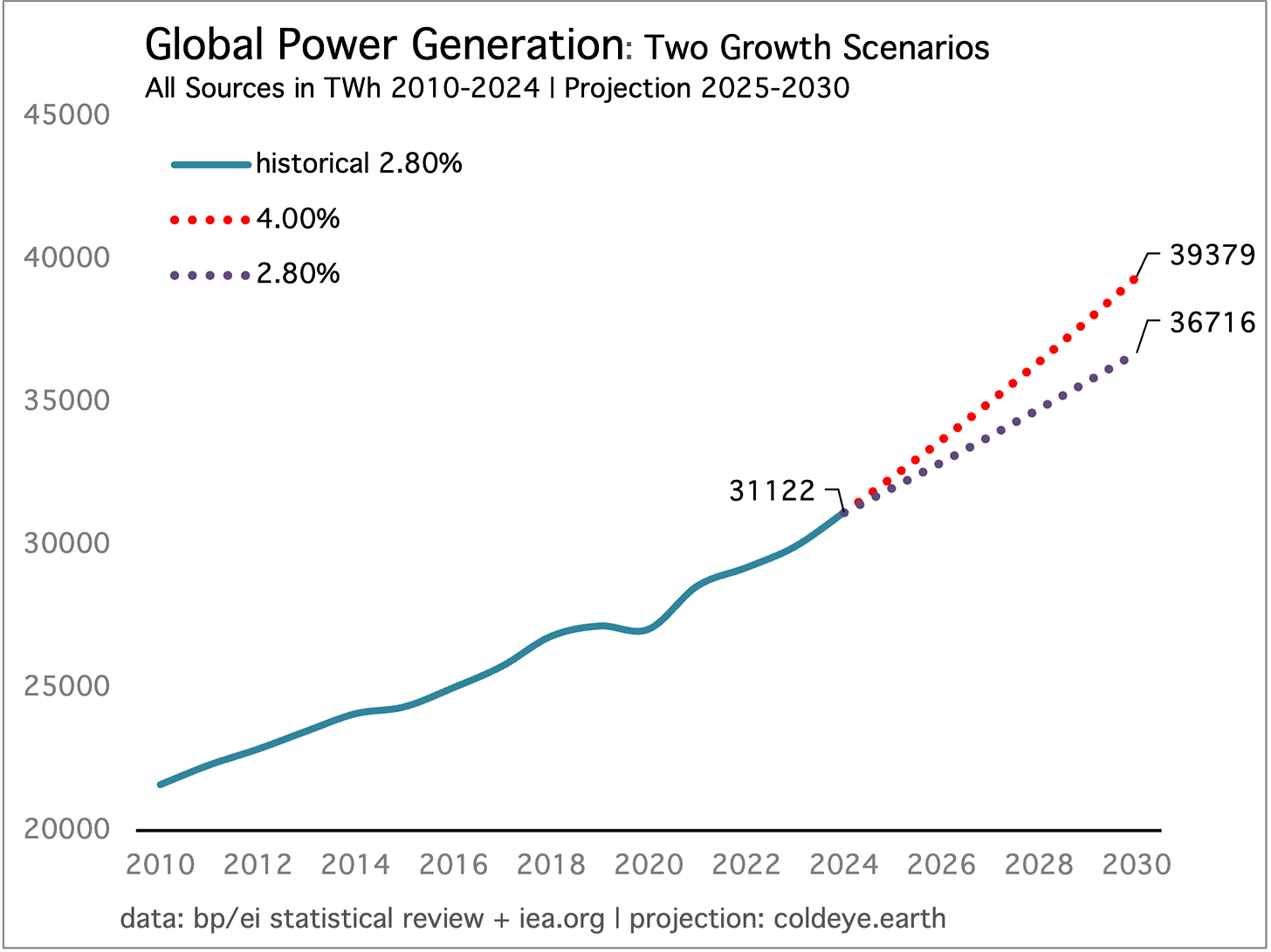Downside of a Power Boom
Monday 17 February 2025
The most recent IEA electricity report confirms no progress will be made in the decarbonization of global power over the next three years as total global system growth is now running so hot it will consume 100% of renewables growth from 2024 through 2027. Cold Eye Earth has warned repeatedly that any sustained acceleration in total system growth would erect an even higher hurdle for decarbonization and the IEA’s Electricity 2025, released just last week, points exactly in that direction—increasing its own forecast substantially that global power grew 4.3% last year, and is set to grow by at least 4.0% each year through 2027. In such a scenario, the fossil fuel underlayer in global power will remain safe and intact, entirely undisturbed or reduced by fast growing renewables.
The forecast also strengthens further the case that energy transition is now lapsing into becoming an Additive, rather than a Transformative, process. In the Additive model, renewables wind up as just another new layer of energy sitting atop all the previous layers, without eating into them. Unfortunately, this is the historical pattern with previous energy transitions and to successfully fight the inexorable surrender to this history will require policies far more radical and aggressive. While Cold Eye Earth has been writing about this emerging problem for about two years now (Cold Eye Earth was renamed in late 2023 and reoriented from The Gregor Letter, precisely for this reason) you can read the fullest summary and expression of this idea in the free, open to the public Momentum Lost issue, published earlier this month.
Now, in previous discussions Cold Eye Earth has provided readers with extensive growth modeling of both renewables, and global power, through the end of this decade. These simple models have shown the historical growth rate of global power and renewables, while laying out a high case and a normal case for growth through the year 2030. What has been their conclusion? That global renewables retained the potential to cover most, if not all, of marginal growth through the end of this decade—as long as total system growth didn’t breakout to the upside. Needless to say, Electricity 2025 converts what had previously been the high case of 4.0% total demand growth into the base case—and that is going to prove extremely challenging for renewables to cover.
Using a steady 4.0% growth rate to the end of the decade, the above chart incorporates EI Statistical Review data through 2023, and applies a 4.0% growth rate to 2024 based on IEA estimates, to obtain the following result: renewables must grow by 8257 TWh (39379 - 31122 = 8257) from this year through 2030 just to keep up with total system growth.
Let’s make this plain: global power is on course to advance a whopping 26.5% in the six years from 2024 through 2030.
The implications are not hard to discern. While the IEA claims in their report that renewables (plus nuclear) will still be able to cover this newly accelerated rate of demand growth, they additionally rely on super volatile hydropower, quirky nuclear power, and worst of all, biomass, to pad their wind and solar growth. That’s a stretch, to say the least. To be honest, the IEA’s claim that “most of the growth will be covered by low carbon resources” sounds like a big scoop of hopium. Indeed, there are global indications that natural gas is ready for a big, new advance while coal still refuses to die.
Cold Eye Earth takes the view, therefore, that power sector emissions will not fall, will not stay flat, but will instead keep rising. Only wind and solar contain the growth visibility upon which a forecast can rely. Wind and solar growth has been amazing, and will continue to be amazing. But you cannot fool emissions data with biomass, and you cannot reliably forecast hydropower which in recent years has acted more like a climate-change barometer, careening between ever more extreme surpluses and drought. Nuclear, meanwhile, may indeed have entered a new era of interest, but the uncertainties over whether retired plants are in fact ever re-opened (the current excitement) makes forecasting shaky.
What’s particularly surprising is that the IEA’s electricity report is absolutely devastating to the project of decarbonization, but few in the climate community seem alarmed by it, so far. Cold Eye Earth offers the following reason why: the bulk of the discourse in climate journalism is completely offsides now, anchored to the trailing view that we will replace fossil fuels in power with renewables, when it’s now crystal clear we’re not on that course at all. This community seems content to keep making serially failed peak emissions forecasts, while tediously “counting renewables” —all of which looks more like a head-banging incantation, rather than analysis.
What are the realistic prospects that renewables can cover what the IEA is now calling a “new age of electricity and unprecedented power growth” through the end of this decade? We can come at this question a number of ways. First, there is the thematic approach which observes that coal hit another all time high last year, that natural gas in power is about to grow even more strongly in the US , and that global economic growth seems to be stirring anew.
Keep reading with a 7-day free trial
Subscribe to Cold Eye Earth to keep reading this post and get 7 days of free access to the full post archives.




